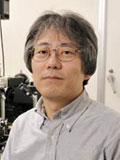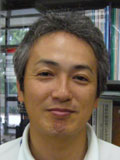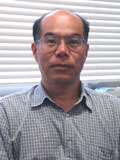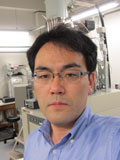Open-type researchers A03: Development (the former period)
Susumu Uchiyama
| Department of Biotechnology, Graduate School of Engineering, Osaka University Associate Professor Okazaki Institute for Integrative Bioscience, National Institutes of Natural Sciences Visiting Associate Professor Ph. D. |
 |
|
| Role: | A03 Open-type Researcher | |
|---|---|---|
| Title: | Exploration of protein complex formation mechanism by mass spectrometry | |
| Purpose: | Molecular assembly has generally been studied by x-ray crystallography, nuclear magnetic resonance spectroscopy and electron microscopy. We have developed alternative methods using mass spectrometry (MS), such as native-MS and hydrogen/deuterium exchange MS (HDX-MS), which are now complemental methods to the aforementioned techniques, for the structural investigation of molecular assembly. In this research project, we will mainly study two large protein complexes that show dynamic assembly-disassembly reaction in solution. The constituent subunits of the protein complexes replace their positions in the complexes as time passes and eventually construct functional large complexes. The assembly processes of the complexes are clarified by using native-MS, providing macroscopic view of the assembly. Concurrently, the interaction sites involved in the assembly and structural alternations are identified by HDX-MS, providing microscopic view of the assembly. The achievement of this research will uncover the micro–macro relationships during large protein complexes formations. |
|
Shigetoshi Oiki
| University of Fukui, Faculty of Medical Sciences, Department of Physiology and Biophysics Professor, M. D., Ph. D. |
 |
|
| Role: | A03 Open-type Researcher | |
|---|---|---|
| Title: | Gating-coupled self-assembly of the KcsA potassium channels on the membrane | |
| Purpose: | Recently, we found unprecedented activities of the KcsA potassium channel on the membrane. First, the channel underwent reversible clustering and dispersion on the membrane, which is tightly coupled to the gating conformational changes (gating-coupled self-assembly). Second, the channel gating exhibited strong dependency on the lipid composition on the membrane inner leaflet, and the lipid sensitivity was rendered to the N-terminal amphipathic helix (M0 helix). These results lead to a scenario for the channel dynamics on the membrane. The lipid sensor detects the negatively charged lipids on the inner leaflet, by which the channel gate was stabilized as the open conformation. The conformational changes in the transmembrane domain altered the interaction between channels, and govern the reversible clustering-dispersion. Coupling of the sub-molecular and supra-molecular events will be examined with the AFM and the single-channel current recordings. | |
Hisashi Okumura
| Research Center for Computational Science, Institute for Molecular Science, National Institutes of Natural Sciences Associate Professor, Ph. D. |
 |
|
| Role: | A03 Open-type Researcher | |
|---|---|---|
| Title: | Theoretical study for the aggregation mechanism of amyloid-beta peptides at a hydrophilic-hydrophobic interface | |
| Purpose: | Neurodegenerative diseases such as Alzheimer’s disease are caused by amyloid fibrils of proteins or peptides such as amyloid-β (Aβ) peptides. The aggregation of Aβ peptides is known to be formed mainly on GM1 ganglioside clusters, which exist on a lipid membrane. To understand the physicochemical mechanism this self-organized biomolecular system, we perform molecular dynamics simulations for the aggregation and disaggregation process of Aβ peptides on a model hydrophilic/hydrophobic interface. We carry out this research with our recent molecular dynamics techniques such as replica-permutation method. | |
Kazuya Kikuchi
| Osaka University, Graduate School of Engineering Osaka University, WPI-Immunology Frontier Research Center Professor, Ph.D. |
 |
|
| Role: | A03 Open-type Researcher | |
|---|---|---|
| Title: | Designed Chemical Probes for Clarification of Spatio-temporal Molecular Function | |
| Purpose: | One of the great challenges in the post-genome era is to clarify the biological significance of intracellular molecules directly in living cells. If we can visualize a molecule in action, it is possible to acquire biological information, which is unavailable if we deal with cell homogenates. One possible approach is to design and synthesize chemical probes that can convert biological information to chemical output. Fluorescence protein labeling by synthetic probes is a powerful approach to investigate protein function and localization inside living cells. This chemistry-based technique utilizes a pair of a protein tag and its specific ligands connected to fluorophores. Its potential advantage is that various fluorescent molecules are available as labeling reagents, and the timing of protein labeling is easily controlled. |
|
Yasushi Sako
| Cellular Informatics Laboratory, RIKEN Chief Scientist, Ph. D. |
 |
|
| Role: | A03 Open-type Researcher | |
|---|---|---|
| Title: | Oligomeirzation dynamics and molecular recognitions of cell surface receptor molecules | |
| Purpose: | Cell surface receptor molecules dynamically rearrange their oligomerization structures responding to the extracellular signaling molecules. In this research project, we will measure and analyze these dynamics using single-molecule imaging in cells. EGF receptor (EGFR) and metabotropic Glu receptor (mGluR) are the main targets. EGFR forms ligand-induced dimers for signal transduction, and molecular rearrangement in the constitutive homo-dimers of mGluR induced by agonist binding is essential for activation. mGluR is also said to form heterodimers with serotonin receptor (5HTR) and mutually regulating their activities. We will analyze dynamics of the movements and oligomerization of these receptor molecules, in addition to the interaction kinetics of the receptors with the ligands, agonists, and intracellular proteins, toward understanding of the physiological meanings of the self-organization of cell surface receptor molecules. | |
Masaki Sasai
| Department of Computational Science and Engineering, Nagoya University Professor, Dr. Sci. |
 |
|
| Role: | A03 Open-type Researcher | |
|---|---|---|
| Title: | From protein structure and dynamics to the systems biology of oscillation | |
| Purpose: | We will develop theoretical methods to analyze pathways and free-energy landscapes of allosteric transitions of proteins. In this project, we will integrate these new methods for investigating molecular properties of proteins with systems biological theories that describe protein-protein interaction dynamics. In particular, we focus on the circadian oscillation of the KaiABC system; Kondo’s group (Nakajima et al., Science, 2005) has shown that a stable oscillation of the phosphorylation level of KaiC with the period of approximately 24h is generated in a mixture of three proteins, KaiA, KaiB, and KaiC, incubated with ATP in solution at around 300K. Although a lot of theoretical models have been proposed to explain the oscillation from nonlinear interactions in this KaiABC system, the oscillation mechanism has not yet been resolved. More recent data showed that allostery and ATPase activity of KaiC are essential for this oscillation (Terauchi et al., PNAS, 2007; Nishiwaki-Ohkawa et al., PNAS, 2014), which implies that the key to understand this system should be found at the interface of molecular-level properties of individual proteins and system-level dynamics of protein-protein interaction. We will investigate this problem by developing multi-scale methods to integrate problems of protein allostery, reactions, and system-level dynamics. | |
Ken Sato
| University of Tokyo, Graduate School of Arts and Sciences Associate Professor, Ph. D. |
 |
|
| Role: | A03 Open-type Researcher | |
|---|---|---|
| Title: | Exploration of dynamic ordering that allows the formation of transport vesicles | |
| Purpose: | In eukaryotic cells, intracellular protein transport between the organelles of the secretory pathway is mediated by transport vesicles that are released from a donor organelle and fuse with an appropriate acceptor organelle. The formation of transport vesicles is mediated by the coordinated action of coat proteins and small GTPases. Small GTPases of the Arf/Sar family on endomembranes regulate the polymerization of the coat protein, which acts as a membrane deforming shell to form transport vesicles. The processes of Arf/Sar-regulated coat assembly on donor membranes and accurate cargo packaging into transport vesicles represent fundamental and largely unresolved problems in cell biology. In this research project, we focus on the formation of transport vesicles and elucidate the mechanisms underlying cargo recruitment, regulated coat protein assembly, and vesicle formation by using in vitro reconstituted system, single-molecule fluorescence imaging, and live-cell imaging. | |
Chikako Shingyoji
| Department of Biological Sciences, Graduate School of Science, The University of Tokyo Associate Professor, Doctor of Science. |
 |
|
| Role: | A03 Open-type Researcher | |
|---|---|---|
| Title: | Mechanical activity of dynein and its dynamical ordering underlying oscillatory movement of sperm flagella | |
| Purpose: | A sperm flagellum is a motile apparatus to bring genetic information to eggs. The movement of sperm flagella, characterized by oscillatory beating or cyclical bending is produced by the spatial control of sliding between adjacent doublet microtubules along the flagellum. Dynein arms generate force for microtubule sliding. The structural hierarchy is coupled with the expression of higher-order function to generate normal flagellar beating, the mechanism of regulation of dynein function requires at least following four levels. These levels are the mechanical activity of single dynein, the sliding activity along each doublet microtubule, the active sliding pattern around the axoneme, and the active sliding responsible for beat initiation. Our goal is to understand the dynamical ordering of dynein function underlying flagellar oscillation. In this project we focus on the nature of dyneins from the view of the above four levels and elucidate dynamical roles of mechanical activity of dynein. | |
Masaaki Sugiyama
| Research Reactor Institute, Kyoto University Professor, Dr. Sci. |
 |
|
| Role: | A03 Open-type Researcher | |
|---|---|---|
| Title: | Study on dynamic equilibrium in biomacromolecular complex systems by small-angle neutron scattering | |
| Purpose: | One of specific features of neutron scattering is distinguishable ability in isotopes, especially between light hydrogen and deuterium. By utilizing this feature, such as deuterazation-labeling, small-angle neutron scattering is one of the most powerful techniques to analyze the domain configuration of protein complex in aqueous solution. In addition, Sugiyama et al., developed this technique and opened to observe subunit-exchange between homo-oligomers. The purpose of the research project is to clarify the process to establish dynamical equilibrium and relation between structural formation the equilibrium, by observing the process of establishing a new equilibrium by adding proteasome α6 oligomers to proteasome α7 oligomer system, where the dynamical equilibrium, the subunit-exchange, is established. | |
Eri Chatani
| Department of Chemistry, Graduate School of Science, Kobe University Associate Professor, Ph. D. |
 |
|
| Role: | A03 Open-type Researcher | |
|---|---|---|
| Title: | Protein association and ordering mechanisms during the amyloidogenic nucleation | |
| Purpose: | Amyloid fibrils are supramolecular protein assemblies associated with numerous serious diseases. The fibril formation generally proceeds according to a nucleation-dependent scheme, and in many cases, the nucleation is a rate-limiting step controlling the overall kinetics of fibril formation. Exploring detailed mechanisms of the nucleation is therefore one of the most essential issues for understanding pathogenesis in terms of protein states, but much remains to be elucidated regarding how and when the amyloidogenic nuclei emerge. In this study, we will investigate early association events of protein molecules as well as surrounding water molecules to clarify a picture of association and ordering mechanism of protein molecules governing the amyloidogenic nucleation. | |
Kazuki Terauchi
| Ritsumeikan University Department of Life Sciences Associate Professor, Ph. D. |
 |
|
| Role: | A03 Open-type Researcher | |
|---|---|---|
| Title: | The analysis of the molecular mechanisms involved in the entrainment of the reconstituted circadian clock. | |
| Purpose: | In this study, we will depict the molecular mechanisms of the circadian clock focused on the entrainment. Circadian clock consisting of the three clock proteins that are the targets of this study exhibits the high precision function that generates a periodicity of 24 hours keeping the order. The circadian rhythm can be reset in vivo by exposure to some external stimuli and this feature is conserved in the reconstituted clock. We will elucidate the mechanisms underlying the entrainment of the reconstituted circadian clock by biochemical analysis. This will facilitate a better understanding of the principles governing the measuring time by proteins coupled with the development of their integrated functions. | |
Kensaku Mizuno
| Department of Biomolecular Sciences Graduate School of Life Sciences Tohoku University Professor, Ph. D. |
 |
|
| Role: | A03 Open-type Researcher | |
|---|---|---|
| Title: | Dynamic ordering of actin cytoskeletal supramolecular complex and its roles in cell migration and mechanosensing | |
| Purpose: | Actin cytoskeleton is an intracellular supramolecular complex, composed of actin filaments and various actin-binding proteins. The spatiotemporal control of the dynamic ordering of actin cytoskeletal assembly plays a central role in cell morphogenesis, migration, and division. In this project, we will develop the microscopic methods for measuring and quantifying the changes in the concentrations of G-actin and F-actin and bound and free forms of actin-binding proteins in living cells. By combining the sequential FDAP method and the fluorescence single-molecule microscopy, we will elucidate the roles of actin cytoskeletal dynamics in chemotactic response of tumor cells and mechanical stress-induced cell morphological changes. We will also analyze the roles of microtubule dynamics in cell shape change, migration, and spindle and cilium formation. Our study will lead to a better understanding of the regulation mechanisms of dynamic ordering of the cytoskeleton and their roles in cell migration and mechanosensing. | |
Kazuyoshi Murata
| National Institute for Physiological Sciences, National Institutes of Natural Sciences Associate Professor, Ph. D. |
 |
|
| Role: | A03 Open-type Researcher | |
|---|---|---|
| Title: | Analysis of structural ordering and dynamic self-assembly of rotavirus in infection and proliferation | |
| Purpose: | Rotavirus is a non-enveloped icosahedral capsid virus that has been well studied structurally and pathogenically. However, it is unclear how the virus is practically formed in host cell. In this research project, we investigate the structural details of the infection, duplication, and releasing of rotavirus in host cell using state-of-the-art electron microscopy of cryoEM and SBF-SEM. Based on the analyses, we will visually reveal the process of structural ordering of the virus, and propose a model of the dynamical self-assembly in viral particle. | |
